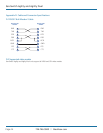
ServSwitch Agility and Agility Dual
724-746-5500 | blackbox.com
Page 42
C.4 Agility transmitter video settings
Each ServSwitch Agility transmitter includes controls to help you customise how video data is transmitted. When configured cor-
rectly for the application, these can help to increase data efficiency.
• Background Refresh The transmitter sends portions of the video image only when they change. In order to give the best user
experience, the transmitter also sends the whole video image, at a lower frame rate, in the background. The Background
Refresh parameter controls the rate at which this background image is sent. The default value is ‘every 32 frames’, meaning
that a full frame is sent in the background every 32 frames. Reducing this to ‘every 64 frames’ or more will reduce the amount
of bandwidth that the transmitter consumes. On a high-traffic network this parameter should be reduced in this way to
improve overall system performance.
• Color Depth This parameter determines the number of bits required to define the color of every pixel. The maximum (and
default) value is ‘24 bit’. By reducing the value you can significantly reduce bandwidth consumption, at the cost of video color
reproduction.
• Peak Bandwidth Limiter The transmitter will employ a ‘best effort’ strategy in sending video and other data over the IP net-
work. This means it will use as much of the available network bandwidth as necessary to achieve optimal data quality, although
typically the transmitter will use considerably less than the maximum available.
In order to prevent the transmitter from ‘hogging’ too much of the network capacity, you can reduce this setting to place a
tighter limit on the maximum bandwidth permissible to the transmitter.
• Frame Skipping This involves ‘missing out’ video frames between those captured by the transmitter. For video sources that
update only infrequently or for those that update very frequently but where high fidelity is not required, frame skipping is a
good strategy for reducing the overall bandwidth consumed by the system.
C.5 Forwarding modes
In essence, the job of a layer 2 switch is to transfer as fast as possible, data packets arriving at one port out to another port as
determined by the destination address. This is known as data forwarding and most switches offer a choice of methods to achieve
this. Choosing the most appropriate forwarding method can often have a sizeable impact on the overall speed of switching:
• Store and forward is the original method and requires the switch to save each entire data packet to buffer memory, run an
error check and then forward if no error is found (or otherwise discard it).
• Cut-through was developed to address the latency issues suffered by some store and forward switches. The switch begins
interpreting each data packet as it arrives. Once the initial addressing information has been read, the switch immediately begins
forwarding the data packet while the remainder is still arriving. Once all of the packet has been received, an error check is per-
formed and, if necessary, the packet is tagged as being in error. This checking ‘on-the-fly’ means that cut-through switches
cannot discard faulty packets themselves. However, on receipt of the marked packet, a host will carry out the discard process.
• Fragment-free is a hybrid of the above two methods. It waits until the first 64 bits have been received before beginning to
forward each data packet. This way the switch is more likely to locate and discard faulty packets that are fragmented due to
collisions with other data packets.
• Adaptive switches automatically choose between the above methods. Usually they start out as a cut-through switches and
change to store and forward or fragment-free methods if large number of errors or collisions are detected.
So which one to choose? The Cut-through method has the least latency so is usually the best to use with Agility units. However, if
the network components and/or cabling generate a lot of errors, the Store and forward method should probably be used. On
higher end store and forward switches, latency is rarely an issue.


















